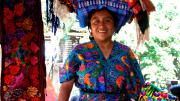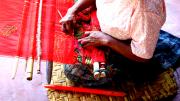Three years ago, Lee Smith ’69, associate vice president for legal affairs at the University of Texas, his wife, Michelle, and their 19-year-old daughter, Allison, visited Al Akhawayn University in Ifrane, Morocco, where Allison eventually enrolled for a year. For Smith, it was his first time back in Morocco since 1975, when he lived there for two months, staying “until either my health or my money ran out,” as he recalls. Though he had been a passionate photographer in college, when “my camera was a permanent extension of my hand,” he had not done any serious photography for 30 years. Meanwhile, digital technology had revolutionized the field that Smith had abandoned out of frustration with his lack of a darkroom and the control of the final image that it offers—a function that darkrooms have now largely ceded to computer software.
During his 1975 Moroccan sojourn, Smith took no pictures, partly because he had been told that its people were averse to being photographed. But on his return trip, he carried a five-megapixel Pentax camera and a determination to “take pictures I could show somebody.” He discovered that Moroccans didn’t mind photographers, that digital photography had arrived, and that “I still had an eye.” Furthermore, he could fine-tune his prints on a computer. “Everything that had turned me off to photography was gone,” he declares. “Now, I’m a second-life photographer.”
“I have always loved the photo essay,” he adds. (In college, he created a number of them for Harvard Yearbook Publications, where he was managing editor as a senior; he has also had photographs published in Time and Cosmopolitan.) In recent years he has made a third voyage to Morocco and two trips to Guatemala, pursuing what he calls “cultural photography.” He asks, “What would a Moroccan see in Morocco? I wanted to become a reflection of that, shooting things a Moroccan would look at and say, ‘This is my culture’—not just something an outsider would be impressed by. I need to see it from their point of view; I can’t just be in a bus somewhere taking a picture.”
To do this, a photographer needs to melt invisibly into the surroundings while remaining present and engaged. Smith’s physical appearance, which he calls “visually ambiguous,” helps: though he’s identified as an African American in the United States, his ethnic heritage, which includes Native American and European elements, has led some to peg him as Peruvian or Italian. “Pakistanis see me and think I am Indian,” he explains, “and Indians see me and assume I am Pakistani.” Furthermore, he adds, “I have never met a stranger.” In Guatemala, for example, he spent time every day with a Mayan woman named Ruth, who sold textiles in the village market. “Her friends, the women who did the weaving, became my friends,” Smith says. “For some reason people open themselves to me and welcome me into their lives.”
Exhibition spaces have also welcomed him to their walls. In the past two years, Smith’s 20-by-30-inch prints have hung in eight different venues, from New York to his hometown of Austin (see www.imagesofmorocco.com). As a “second-life photographer,” he often reflects on a bit of advice he got from Ansel Adams in 1970, but was “too self-absorbed to understand,” he says. “Ansel said, ‘If you want to be a successful photographer, get a job selling shoes.’ What he meant was, if you want to discover your art, find a day job that pays the rent and puts food on the table, because if you depend on photography to do that, you will be consumed by taking the pictures people pay you for, and will never discover your own art. Maybe practicing law is something like selling shoes.”













